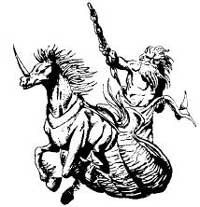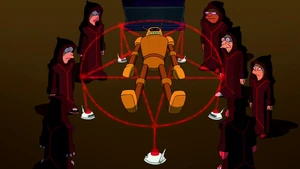TECHNOMANCERS
A technomancer is a magician that uses a weird melding of science and superstition to attain objectives or acquire knowledge (and, or) wisdom using the arcane arts of the ancients. Such practitioners describe their "magic" in rational terms, using mathematical formulas, technobabble and pseudoscience to achieve their goals.
Technomancers throw around words like "quantum," "tachyon" and "string theory" to explain away just about anything. (And any player character Technomancer had better do the same!)
History: Even before the Apocalypse, most of the scientific lore of the Ancients was so couched in obscure terminology that each branch of science was only really understood by a small number of "specialized" individuals. It had all become so academically arcane and hard to decipher, that the vast majority of scientists kept mostly to their own departments. So when the Apocalypse came, knowledge was thrown to the wind, and the already weird sciences of the Ancients became all the more arcane and weird.
In the "modern" era of Atomic Dawn, Technomancers are the wizards and weird scientists (is there a difference?) that wander the wastelands and serve communities. Many of these magicians are part charlatan, part sooth-sayer and part mechanic.
Benefit: Technomancer characters can use Ritual Magic, beginning play with 1d4 rituals (Mutant Lords discretion). Furthermore, technomancers who reach 9th level can create their own artifacts.
Prerequisites: Technomancers MUST have an INT of at least 14, and choose Technobabble as a starting language.
Ritual Magic
These rules were originally put down
here at the OSR Library. I will be expanding on the concept of technomantic rituals in future articles.
Casting Ritual Spells
To cast a Spell the following steps must be achieved:
Format
The Spell must be found or taught. Grimoires, scrolls, writings carved on walls, alien tutors, mad hermits, magical lodges, etc.
Learning New Spells
Learning how to cast the spell takes eight hours per spell level. A fifth level spell would take forty hours of study and practice to learn.
Material Components
Technomantic rituals require components such as assorted relic junk, computer components, power sources, pentagrams, crystals, specific manuals, A.I. intervention, etc.
Casting Time
Casting requires ten (10) minutes per spell level. A fifth level Spell takes fifty minutes minimum to cast. The DM may require materials to be used as well. The main cost of this type of casting is time. Time can be incredibly valuable in a dungeon or during a Mythos incident.
The Casting Roll.
To actually cast the Spell requires an Int check with a penalty equal to the Spell Level. A character with an Int of 13 attempts to cast the fifth level spell. The Spell will succeed if he rolls a 1-8 on a 1d20.
Extra casting time can increase this chance. For each full casting time increment past the minimum the caster can add a + 2 to the roll.
Four times the minimum is the most that this method can be used.
For the fifth level spell: if the time taken is 50 minutes the roll is still an 8.
If 100 minutes is taken the roll is now 10.
For 150 Minutes the roll is 12.
For 200 minutes the roll is 14.
If the Casting Roll fails:
Time and consumable materials are lost. The caster can attempt the Spell again with an additional -4 penalty to the total Casting Roll or he can wait 24 hours and avoid this penalty.
Multiple Casters:
The person leading the ritual uses his Casting Roll. For each additional caster add a +1 to the roll. The maximum bonus is equal to the Spell's level. The fifth level Spell would have a maximum of a +5 bonus no matter how many actually participated in the ritual.
Used in conjunction with extra casting time this option can really increase the chance of the casting roll's success.
SAMPLE SPELLS
Ritual spells are typically pretty powerful, so I suggest spells of at least 4th level, taken from Labyrinth Lord. Spells such as Magic Missile are much less powerful that a laser pistol, and so should not be converted into a ritual (it would take too long to cast to be useful in combat).
So, taken from Labyrinth Lord, here are a handful of sample rituals:
Animate Walking Dead
Level: 5
Duration: Permanent
Casting Time: 50 minutes
Range: 60ft
This spell turns the bodies of dead creatures into Walking Dead that follow the caster's spoken
commands. The undead can follow the caster, or they can remain in an area and attack any creature (or just a specific kind of creature) entering the place. They remain animated until they are destroyed or until a dispel magic spell is cast upon them.
The caster may animate a number of hit die worth of walking dead equal to the caster's level. For example, a 10th level technomancer can animate 2 walking dead. These creatures are unintelligent, and do not retain
any abilities that they had in life.
Material Component: A fully charged power pack.
Cybernetic Graft
Level: 3
Duration: Permanent
Casting Time: 30 minuted
Area of Effect: 1 creature
Range: See below
Through the ritual cybernetic graft a magician may graft robot or android parts to himself or another creature. The parts to be grafted must be in working order and clean. Normally, a recipient of Cybernetic Graft will have lost a limb or other body part (eye, ear, etc) thus requiring a replacement. This is not always the case however, with creatures lacking useable limbs or other circumstances being fairly common.
Cybernetic parts require an additional power source, usually a battery pack to function for 1d4 weeks, after which the robotic limb will cease working.
Material Component: In-tact and fully functioning robotic part. For arms I suggest pinchers or basic hands (see page 127 in Mutant Future).
Simulacrum
Level: 7
Duration: Permanent
Casting Time: 70 minutes
Range: Touch
Simulacrum creates a pseudo duplicate of any creature. The spell is cast over a rough mechanical form, and some piece of the creature to be duplicated (blood, brain matter, etc) must be placed inside robot. The simulacrum appears to be the same as the original, but it has only one-half of the real creature's hit points. The duplicate has a faulty memory of the original's life, but will remember most details 30% of the time.
At all times the simulacrum remains under the caster's absolute command. No special telepathic link exists, so command must be exercised in some other manner. A simulacrum has no ability to become more powerful. It cannot increase its level or abilities. If reduced to 0 hit points or otherwise destroyed, a simulacrum reverts to a machine and collapses instantly into a pile of plastic and metal.
Material Component: A (blank) mechanical body, and a piece of the creature to be duplicated.











